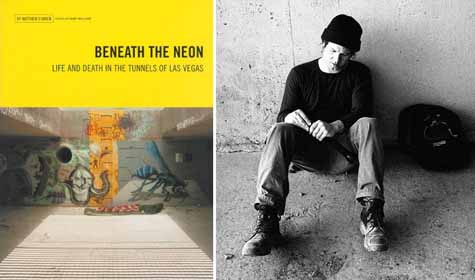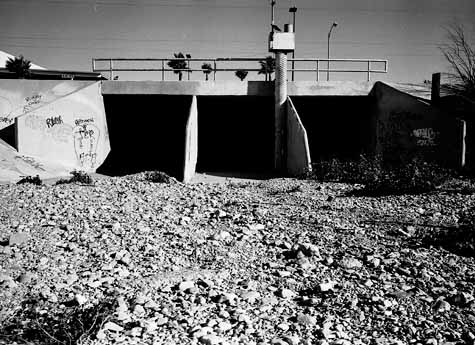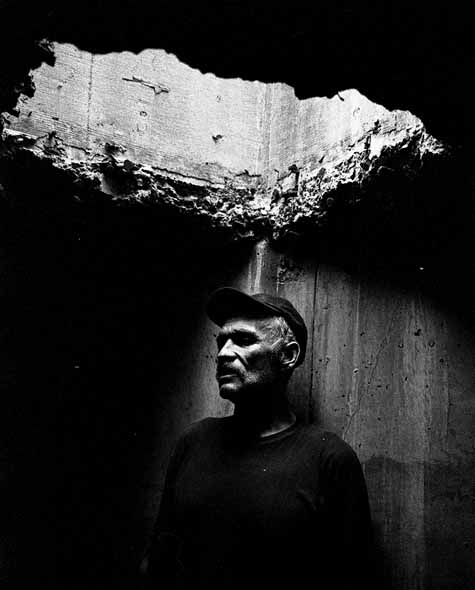Beneath the Neon
 [Image: Beneath the Neon by Matthew O'Brien, with a photo of O'Brien, by Danny Mollohan].
[Image: Beneath the Neon by Matthew O'Brien, with a photo of O'Brien, by Danny Mollohan].I was intrigued to learn that Las Vegas, instant city of fast food and shrimp buffets, air-conditioning itself in the middle of the desert, actually rests upon a veritable labyrinth of flood-control tunnels, almost all of which have been constructed since 1988. This sub-desert network, literally beneath the neon of Las Vegas, is now expanding rapidly: 413 miles of new tunnels, at an estimated cost of $1.7 billion, are planned over the next 30 years.
In a recent book called Beneath the Neon: Life and Death in the Tunnels of Las Vegas, author Matthew O'Brien goes down into that complex of storm-sensitive concrete waterways to document both the occasional flash flood – and the people who have taken up residence there.
 [Image: From Beneath the Neon; photo by Danny Mollohan].
[Image: From Beneath the Neon; photo by Danny Mollohan].In a brief email exchange with BLDGBLOG, O'Brien explained to me that his interest in writing the book "started with a murder."
- A guy named Timmy "T.J." Weber killed his girlfriend and one of her sons and raped her 14-year-old daughter. He was on the run for a week, then returned to the crime scene and attacked one of the surviving family members. The police descended on the scene – but Weber vanished. When he was caught a few weeks later in a trailer park, he told police he used a storm drain to go underneath the dragnet.
That piqued my interest. I wondered what Weber experienced in the storm drains. What he saw, what he heard, what he smelled. How, apparently without a light source, he’d splashed more than three miles upstream. I also wondered what was beneath Las Vegas. What secrets the storm drains kept.
 [Image: From Beneath the Neon; photo by Danny Mollohan].
[Image: From Beneath the Neon; photo by Danny Mollohan].For instance, O'Brien found that "hundreds of people – veterans, women, children – are living in the storm drains of Las Vegas, addicted to drugs and gambling, dying of diseases and getting washed away during floods."
I asked him about some of the people he met down there, and he replied that "there have been several memorable experiences."
- Exploring a wet drain under McCarran International Airport one night, I discovered a man named Lawrence sleeping on an elevated bed. The bed, which was about four and a half feet from the floor, was made of couch cushions, a steel frame and a door that provided additional support. Baling wire looped around the head and foot of the bed, angled tightly through the manhole, and wrapped around the rungs. Backpacks hung from the side on hooks.
I squatted and swept the beam of my flashlight under the bed. It was legless. No steel poles, no wooden beams, no milk crates – nothing. A square-shaped wire dangled from the side, serving as a stepladder. Except for his bikes, the whole camp was at least three feet above the stream of urban runoff.
Lawrence told me he designed the bed after reading about mountain climbers at a local library. "This is how they sleep when they stop and rest in the middle of a climb," he explained.
Also, encountering madmen wandering around in the depths of a drain, without a light source, is something I won’t forget. That happened on a few occasions. Madwomen, too.
I stumbled on a naked man and woman smoking crack in a drain behind a Budget Suites. A man, who lived in a three-foot-in-diameter lateral pipe, washing his clothes in a stream of runoff. Street teens setting up home.
There were several experiences like this, strange but very real, most of which are detailed in the book.
 [Image: From Beneath the Neon; photo by Danny Mollohan].
[Image: From Beneath the Neon; photo by Danny Mollohan].I will say that the writing can be a little uneven at times – the dialogue, for instance, is often a bit Bill & Ted-like, which is unfortunate because the material is sociologically important enough without needing to remind us that the writer and his friends are Really Cool – but if you come across a copy, be sure to check it out!
(Note: All photos in this post by Danny Mollohan. Figures for the Las Vegas Flood Control District's expansion – 413 miles of tunnel worth $1.7 billion over the next 30 years – come from Beneath the Neon).





Comments are moderated.
If it's not spam, it will appear here shortly!
Phrones pointed me in your direction, enjoyed. As a young teen we explored the storm drains under suburban Calif. Close as we could get to Lewis and Clark.
Reminds me of a book about the people who live in the new york subway tunnels. Was also very fascinating. The title was something like: The Mole people.
am going to buy this book cause it sounds very interesting
Post a Comment